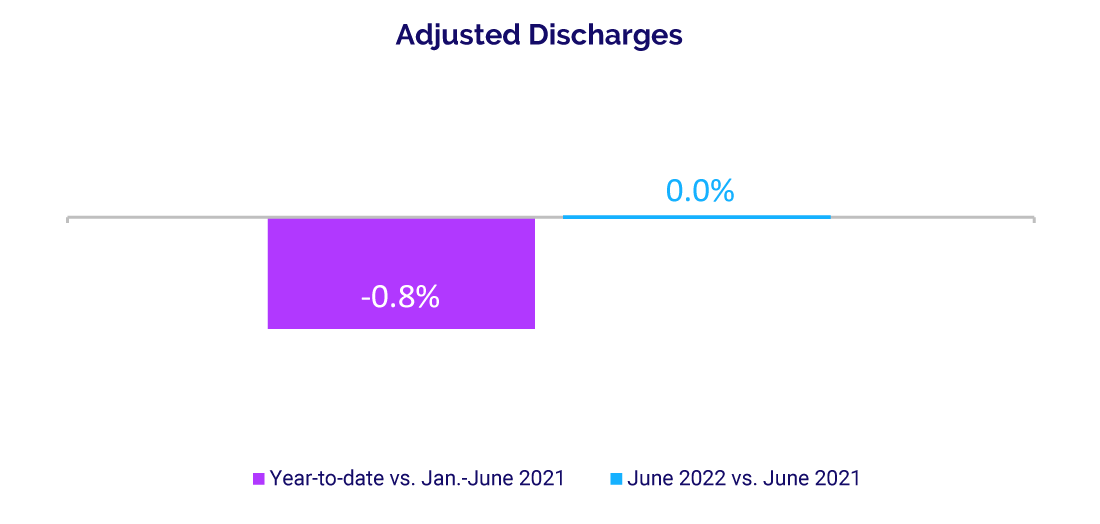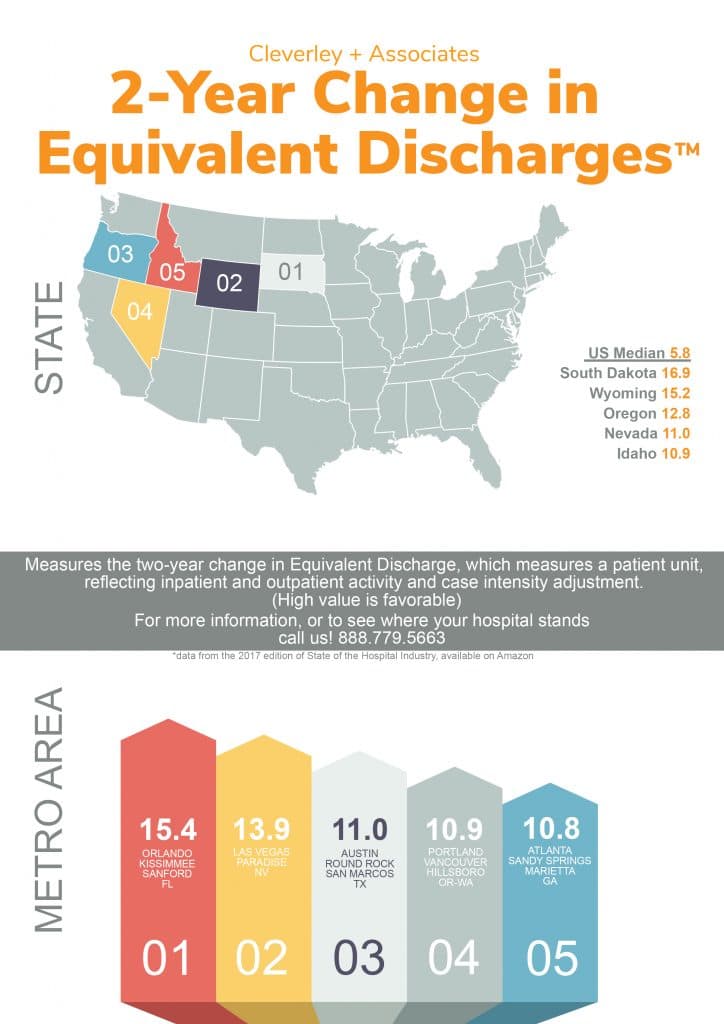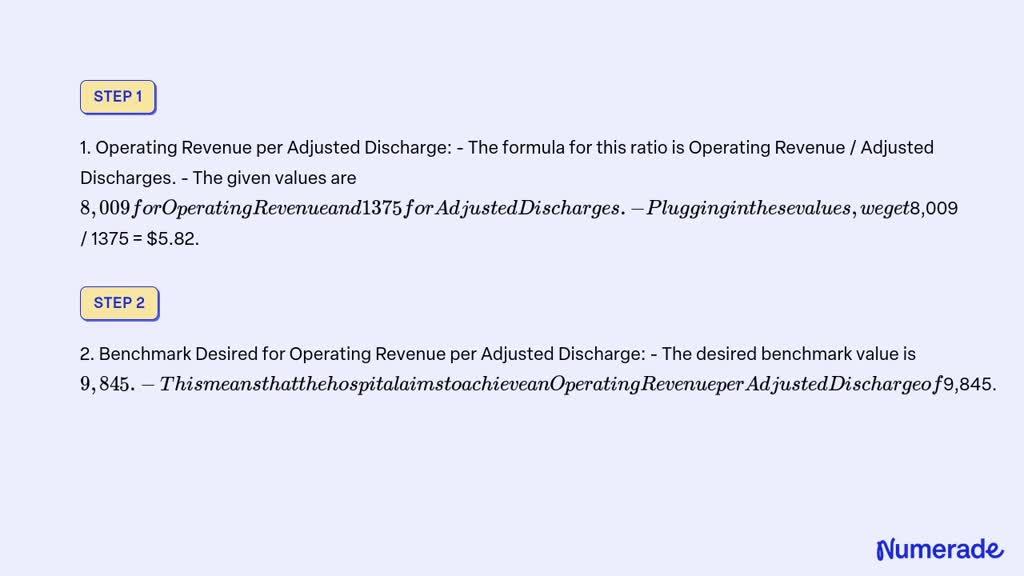Adjusted Discharges - Adjusted patient days this figure is used as a way to standardize the per unit measure between hospitals allowing for more valid comparisons. Adjusted discharges are a common metric for hospital volume, but they are biased by outpatient prices and case mix. Discharges are adjusted (multiplied by an adjustment factor) such that “adjusted discharges” refer to the number of discharges.
Adjusted discharges are a common metric for hospital volume, but they are biased by outpatient prices and case mix. Discharges are adjusted (multiplied by an adjustment factor) such that “adjusted discharges” refer to the number of discharges. Adjusted patient days this figure is used as a way to standardize the per unit measure between hospitals allowing for more valid comparisons.
Adjusted patient days this figure is used as a way to standardize the per unit measure between hospitals allowing for more valid comparisons. Discharges are adjusted (multiplied by an adjustment factor) such that “adjusted discharges” refer to the number of discharges. Adjusted discharges are a common metric for hospital volume, but they are biased by outpatient prices and case mix.
Adjusted discharges
Discharges are adjusted (multiplied by an adjustment factor) such that “adjusted discharges” refer to the number of discharges. Adjusted patient days this figure is used as a way to standardize the per unit measure between hospitals allowing for more valid comparisons. Adjusted discharges are a common metric for hospital volume, but they are biased by outpatient prices and case mix.
Market Analysis and Monthly Hospital & Physician KPIs July 2022
Adjusted discharges are a common metric for hospital volume, but they are biased by outpatient prices and case mix. Adjusted patient days this figure is used as a way to standardize the per unit measure between hospitals allowing for more valid comparisons. Discharges are adjusted (multiplied by an adjustment factor) such that “adjusted discharges” refer to the number of discharges.
Data Sample 2Year Change in Discharges Cleverley & Associates
Discharges are adjusted (multiplied by an adjustment factor) such that “adjusted discharges” refer to the number of discharges. Adjusted patient days this figure is used as a way to standardize the per unit measure between hospitals allowing for more valid comparisons. Adjusted discharges are a common metric for hospital volume, but they are biased by outpatient prices and case mix.
Figure 3.3. Age, Sex, Race and Illness Adjusted Discharges for All
Discharges are adjusted (multiplied by an adjustment factor) such that “adjusted discharges” refer to the number of discharges. Adjusted patient days this figure is used as a way to standardize the per unit measure between hospitals allowing for more valid comparisons. Adjusted discharges are a common metric for hospital volume, but they are biased by outpatient prices and case mix.
Postdischarge revisits at hospitals with high and low adjusted
Adjusted patient days this figure is used as a way to standardize the per unit measure between hospitals allowing for more valid comparisons. Discharges are adjusted (multiplied by an adjustment factor) such that “adjusted discharges” refer to the number of discharges. Adjusted discharges are a common metric for hospital volume, but they are biased by outpatient prices and case mix.
Solved Find operating revenues per adjusted discharge and
Adjusted discharges are a common metric for hospital volume, but they are biased by outpatient prices and case mix. Adjusted patient days this figure is used as a way to standardize the per unit measure between hospitals allowing for more valid comparisons. Discharges are adjusted (multiplied by an adjustment factor) such that “adjusted discharges” refer to the number of discharges.
Care New England Women & Infants Efficiency & Effectiveness Metrics ppt
Discharges are adjusted (multiplied by an adjustment factor) such that “adjusted discharges” refer to the number of discharges. Adjusted patient days this figure is used as a way to standardize the per unit measure between hospitals allowing for more valid comparisons. Adjusted discharges are a common metric for hospital volume, but they are biased by outpatient prices and case mix.
Figure 3.4. Rates of Discharges for All Medical Conditions Unadjusted
Discharges are adjusted (multiplied by an adjustment factor) such that “adjusted discharges” refer to the number of discharges. Adjusted patient days this figure is used as a way to standardize the per unit measure between hospitals allowing for more valid comparisons. Adjusted discharges are a common metric for hospital volume, but they are biased by outpatient prices and case mix.
Figure 3.6. Age and Sex Adjusted Discharges for All Medical Conditions
Adjusted discharges are a common metric for hospital volume, but they are biased by outpatient prices and case mix. Discharges are adjusted (multiplied by an adjustment factor) such that “adjusted discharges” refer to the number of discharges. Adjusted patient days this figure is used as a way to standardize the per unit measure between hospitals allowing for more valid comparisons.
SOLVED Profitability Ratios Assignment Newport Hospital Ratio A
Adjusted patient days this figure is used as a way to standardize the per unit measure between hospitals allowing for more valid comparisons. Adjusted discharges are a common metric for hospital volume, but they are biased by outpatient prices and case mix. Discharges are adjusted (multiplied by an adjustment factor) such that “adjusted discharges” refer to the number of discharges.
Adjusted Discharges Are A Common Metric For Hospital Volume, But They Are Biased By Outpatient Prices And Case Mix.
Adjusted patient days this figure is used as a way to standardize the per unit measure between hospitals allowing for more valid comparisons. Discharges are adjusted (multiplied by an adjustment factor) such that “adjusted discharges” refer to the number of discharges.









